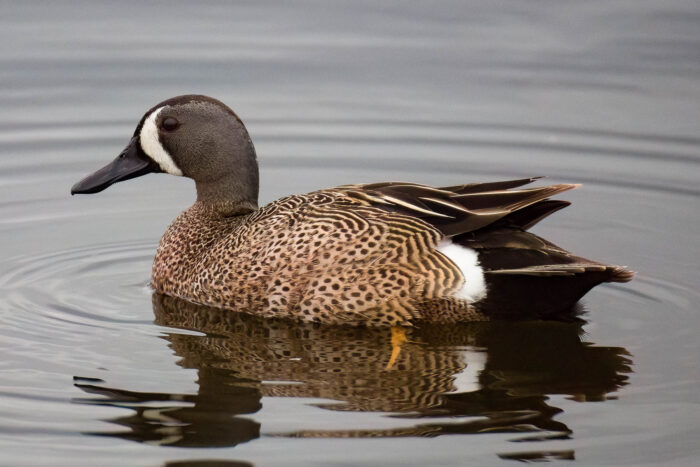Blue-Winged Teal
Anas discors
This small dabbling duck is named for the powder-blue patches on its forewings. It can be found in the marshes and wetlands of the Chesapeake region in spring and fall.
This section shows one large critter image at a time. Use the thumbnails that follow to select a specific image to display here.

This gallery contains a grid of small thumbnails. Selecting a thumbnail will change the main image in the preceding section.
Appearance
The blue-winged teal is a small dabbling duck with a chalky-blue patch on its forewing. It has a rounded head with a slightly large, black bill. The male has a blue-gray head with a bold white crescent on its face. It black speckles cover its gray breast and tan sides, and white patches appear on the sides of its rump. The female is brown and mottled, with a gray-brown scalloped pattern on its flanks and back. Females are smaller than males. Both have the powder-blue forewing patch and green on the back section of feather sknown as the speculum. The blue-winged teal typically grows to 14 to 15 inches in length, 10 to 18 ounces in weight and have a wingspan of 22 to 24 inches.
Feeding
Pairs and small groups of blue-winged teals will dabble and occasionally titly and submerged half their body to reach underwater vegetation. These ducks prefer to forage in shallow water and will often choose a concealed spot near the edge of a pond to feed. They mainly feed on the seeds of various grasses, sedges and pondweed. Occasionally, they feed on aquatic insects, crustaceans, clams and snails.
Predators
Long-tailed weasels often consume blue-winged teal eggs. Female teals are susceptible to predation by raptors, such as bald eagles and great horned owls, when nesting. Foxes, raccoons and skunks also prey on blue-winged teals.
Flight
These ducks can be identified in flight by the blue shoulder patches on the front of their wings.
Voice
Males a whistle-sounding peep or bleat; females have a loud, low quack.
Reproduction and life cycle
Courtship begins in late January to early February, and nesting begins in mid-April to mid-May. Nests are built among grasses or other plants, with vegetation concealing most nests on all sides. The female builds a nest by scraping her feet to make a circular depression. She then lines it with dried grasses and feathers. Females lay one clutch of 6 to 14 eggs, which she incubates for around 24 days. Young can leave the nest to forage within 24 hours after hatching; they are tended to by females for the first few weeks but are often left alone before they are old enough to fly. Young are capable of flight 40 days after hatching. Blue-winged teals can live up to 17 years.
Did you know?
- Blue-winged teals often migrate over very long distances. One individual banded in Alberta, Canada, was found in Venezuela just one month later.
- Blue-winged teals are often the first ducks to migrate south in the fall and the last ones to migrate north in the spring.
- After the mallard, the blue-winged teal is the second most abundant duck in North America.
Sources and additional information
- Chesapeake Bay: Nature of the Estuary, A Field Guide by Christopher P. White
- Peterson Field Guide to the Birds of Eastern and Central North America by Roger Tory Peterson
- All About Birds: Blue-winged Teal – The Cornell Lab of Ornithology
- Blue-winged Teal – Audubon Field Guide to North American Birds
- Animal Diversity Web: Anas discors – University of Michigan Museum of Zoology
